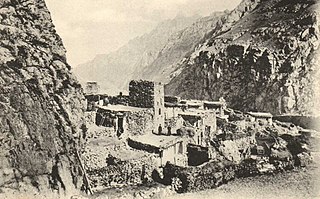
Kumyks are a Turkic ethnic group living in Dagestan, Chechnya and North Ossetia. They are the largest Turkic people in the North Caucasus.

The Sadz or Asadzwa, also Jigets, are a subethnic group of the Abkhazians. They are sometimes purported to have originated from the Sanigoi tribe mentioned by the Classic authors. In the 6th century, they formed a tribal principality, which later commingled with the Abasgoi, Apsilae and Missimianoi into the Kingdom of Abkhazia.
The Institute of Anthropology and Ethnography or N.N. Miklukho-Maklai Institute of Ethnology and Anthropology is a Russian institute of research, specializing in ethnographic studies of cultural and physical anthropology. The institute is a constituent institute of the History branch of the Russian Academy of Sciences, with its main building on Leninsky Prospekt, Moscow. The institute is named after the 19th century ethnologist and anthropologist Nicholas Miklouho-Maclay.
Alla Yervandovna "Yervandi" Ter-Sarkisiants was a historian and ethnographer of Armenia, doctor of historical sciences, leading specialist of the Caucasus department of N. N. Miklukho-Maklai Institute of Ethnology and Anthropology of the Russian Academy of Sciences, and a corresponding member of the Russian Academy of Natural Sciences.

Victor Alexandrovich Schnirelmann is a Russian historian, ethnologist and a member of Academia Europaea. He is a senior researcher of N. N. Miklukho-Maklai Institute of Ethnology and Anthropology at the Russian Academy of Sciences and an author of over 300 works, including over 20 monographies on archaeology. Schnirelmann's main fields include the ideologies of nationalism in Russia and CIS, ethnocentrism and irredentism.

The Siberians or Siberiaks are the majority inhabitants of Siberia, as well as the subgroup or ethnographic group of the Russians.

The Shamkhalate of Tarki, or Tarki Shamkhalate was a Kumyk state in the eastern part of the North Caucasus, with its capital in the ancient town of Tarki. It formed on the territory populated by Kumyks and included territories corresponding to modern Dagestan and adjacent regions. After subjugation by the Russian Empire, the Shamkhalate's lands were split between the Empire's feudal domain with the same name extending from the river Sulak to the southern borders of Dagestan, between Kumyk possessions of the Russian Empire and other administrative units.

Indonesian Bethel Church or Bethel Full Gospel Church of God abbreviated as GBI is a group of Christian Pentecostal churches in Indonesia. It is a member of Church of God. The headquarters of the organisation is in Jakarta.
Kumykia, or rarely called Kumykistan, is a historical and geographical region located along the Caspian Sea shores, on the Kumyk plateau, in the foothills of Dagestan and along the river Terek. The term Kumykia encompasses territories which are historically and currently populated by the Turkic-speaking Kumyk people. Kumykia was the main "granary of Dagestan". The important trade routes, such as one of the branches of the Great Silk Road, passed via Kumykia.

The Rutul Federation or The Rutul Free Society is a Rutul state located in Southern Dagestan and was formed in the 7th century.
Vitii is an ancient tribe that lived on the territory of Caucasian Albania and today in village Nic Qabala region Azerbaijan udins Some scholars believe that the Vitii were Caucasian Albanians, while others consider them to have migrated to the Caucasus by the ancient Greeks. Some consider the Vitii to be the ancestors of the modern Udins, but according to other statements, these two tribes could live at the same time. V.V. Nikolaev identifies the Vitii with Gutians. A.A. Tuallagov describes the Vitii as Caucasian Tocharians and says that they came from the territory of the Yuezhi tribe.
Circassians is a broad ethnonym of the Turkic origin, which in Russia, Turkey and Persia used to be, and in the case of Turkey is now, applied to peoples of different ethnicities living on the North Eastern and Eastern shores of the Black Sea, and in the Northern Caucasus.
Gligvi is a medieval ethnonym used in Georgian, Russian and Western European sources in the 16th-19th centuries. The ethnonym corresponds to the self-name of the Ingush, Ghalghaï.

Fappi or Fappi mokhk, exonym: Kistetia, is a historical region in Ingushetia. Fappi is the territory of historical settlement of the Fyappiy society.

Galashians, were a historical Ingush ethnoterritorial society, which formed in the middle of the 18th century. The name comes from the village of Galashki, which is geographically located in the very center of the society. Galashians were located in the middle and lower reaches of the river Assa and the basin of the river Fortanga.
Ingush societies or shahars were ethnoterritorial associations of the Ingush based on the geographical association of several villages and intended for conditional administrative-territorial delimitation of the Ingush ethnic group. The formation and functioning of most of them dates back to the late Middle Ages. During this period, their boundaries, number and names changed.

Zaur or Zaurovo was an Ingush village that existed in the 18th–19th centuries on the right bank of the Terek River and in the Tarskoye Valley.

The Dzherakh, also spelled Jerakh, historically also known as Erokhan people, were a historical Ingush ethnoterritorial society, today a tribal organization/clan (teip), that was formed in the Dzheyrakhin gorge, as well as in the area of the lower reaches of the Armkhi River and the upper reaches of the Terek River.

Khamkhins, also known as Ghalghaï, were a historical Ingush ethnoterritorial society, which was located in the upper reaches of the Assa River. The Khamkhin society, like the Tsorin society, was formed from the former "Ghalghaï society" as a result of the transfer of rural government to Khamkhi.

Gveleti, is a village (aul) in the Kazbegi Municipality of Georgia. It is located in the Darial Gorge, on the right bank of the Devdaraki, 4 km from the border with Russia. Gelatĕ was founded by the Ingush clan (teip) Gelatkhoy.